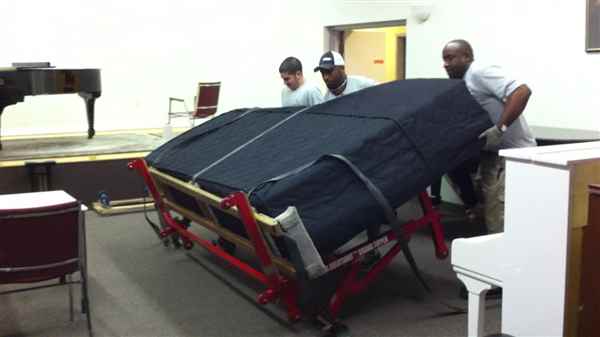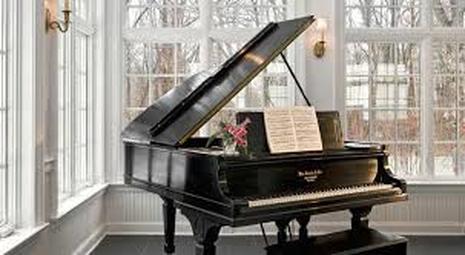Piano MovingPiano 101
Large upright pianos are fairly heavy. The largest uprights have high backs, with heights reaching up to 60 inches and weights hitting 800+ lbs. The smallest grand piano starts at 54 inches long and has an approximate weight of 500–600 lbs. Grand pianos can range out to 110 inches long; a 9-foot concert grand piano can weigh approximately 1000–1200 lbs. Most of a piano's weight is due to the cast iron that holds the strings. Smaller upright pianos can weigh 300–400 pounds since they have smaller cast iron harps. Larger uprights range from 500 pounds to well over 800 pounds. Grand pianos range from 500 pounds to well over 1,200 pounds and can be fairly long, ranging from 4 to 12 feet to over 6 feet. Due to this, any large upright over 48" high or a grand piano over 6 feet long is not a DIY project. These larger pianos should always be moved by professional movers due to their extreme weight. Another interesting and often overlooked fact is that pianos should not be rolled around on their casters. The casters are merely decorative and not functional. They can easily mar wood and other softer flooring. Over time, as a piano sits, the casters tend to deteriorate. Pushing an older piano on its caster can cause legs to break and other serious damage. |
|
Piano Moving
Whenever a 4-wheel piano dolly can be used to transport the piano—muscle power on the part of the team to move it—the weight is minimized to almost zero. This is because all of the piano's weight is essentially supported by the dolly. A piano rightly balanced on a dolly is almost weightless and easily exceeds inertia on level surfaces. At Scranton Moving, we use a dolly as much as possible.
It is always the safest and easiest way to move a piano around. A dolly can be used to move a piano over even ground, on slight inclines and ramps, or for tipping it up or down to get over a curb or a single step. The piano dolly is also used to move the piano over plywood or masonite to go across the grass, gravel, sand, cobblestones, or any other slightly non-even or loose surface. When moving this way, though, we always use at least 4 or 5 movers to push it and rotate the plywood or masonite.
When searching for piano movers, it's important to find not just cheap movers but affordable movers who are experienced local movers, ensuring your prized instrument is handled with care and professionalism.
Let Scranton Moving to move your piano. We originally started 50 years ago as a piano mover, so we know piano moving. We use trucks with hydraulic gates, piano dollies, and 4-5-man crews for the largest upright and grand pianos. So whether you need your piano moved within your house, across town, or transcontinentally, please call us for all your piano moving needs.
Whenever a 4-wheel piano dolly can be used to transport the piano—muscle power on the part of the team to move it—the weight is minimized to almost zero. This is because all of the piano's weight is essentially supported by the dolly. A piano rightly balanced on a dolly is almost weightless and easily exceeds inertia on level surfaces. At Scranton Moving, we use a dolly as much as possible.
It is always the safest and easiest way to move a piano around. A dolly can be used to move a piano over even ground, on slight inclines and ramps, or for tipping it up or down to get over a curb or a single step. The piano dolly is also used to move the piano over plywood or masonite to go across the grass, gravel, sand, cobblestones, or any other slightly non-even or loose surface. When moving this way, though, we always use at least 4 or 5 movers to push it and rotate the plywood or masonite.
When searching for piano movers, it's important to find not just cheap movers but affordable movers who are experienced local movers, ensuring your prized instrument is handled with care and professionalism.
Let Scranton Moving to move your piano. We originally started 50 years ago as a piano mover, so we know piano moving. We use trucks with hydraulic gates, piano dollies, and 4-5-man crews for the largest upright and grand pianos. So whether you need your piano moved within your house, across town, or transcontinentally, please call us for all your piano moving needs.

